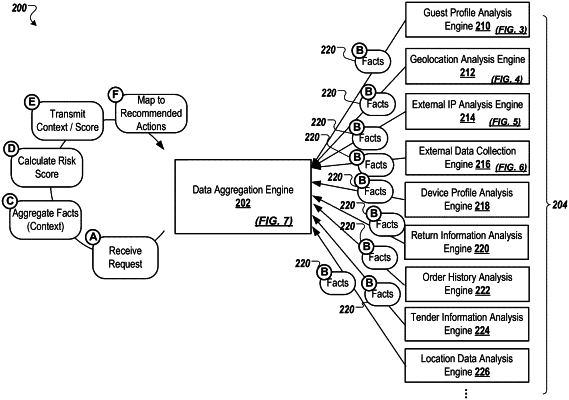| CPC H04L 63/1433 (2013.01) [G06N 5/04 (2013.01)] | 18 Claims |

|
1. A method for assessing risks posed by a website guest, the method comprising:
receiving, at a computing device, a request for an internal reputation of a guest using a guest device interacting with a website;
collecting, at the computing device, guest-related data from a plurality of different service engines, wherein the plurality of different service engines includes a guest profile analysis engine, the guest profile analysis engine configured to perform operations comprising:
identifying the guest device information about the guest device, wherein the guest device information includes three or more browser attributes, the browser attributes being selected from the group consisting of: browser type, version, installed fonts, OS, platform, version incrementing, cookies, do-not-track mode, internal storage, user agent, vendor, renderer, resolution, and time zone;
retrieving historical device information about a plurality of devices having interacted with the website;
comparing the guest device information with the historical device information;
determining a matching between the guest device and any of the plurality of devices; and
generating facts based on the comparison and the matching determination, the facts being part of the guest-related data;
aggregating, at the computing device, contextual information from the guest-related data;
calculating, at the computing device, a risk score based on the contextual information, the risk score representative of the internal reputation of the guest using the guest device;
comparing the risk score against a plurality of threshold risk score values to determine whether to modify current authentication requirements on the website for the guest, wherein the plurality of threshold risk score values comprise a first threshold risk score value and a second threshold risk score value, wherein the first threshold risk score value is less than the second threshold risk score value;
generating, at the computing device, a recommended action with regard to the current authentication requirements based on the comparison between the risk score and the plurality of threshold risk score values, wherein the recommended action is selected from among (i) lowering the current authentication requirements on the website for the guest based on the risk score being less than the first threshold score value, (ii) elevating the current authentication requirements on the website for the guest based on the risk score exceeding the second threshold risk score value, and (iii) maintaining the current authentication requirements on the website for the guest based on the risk score being between the first and second threshold risk score values; and
transmitting, at the computing device, the recommended action or the risk score to a remote computing device, the remote computing device configured to modify content of the website according to the recommended action to lower, elevate, or maintain the current authentication requirements on the website for the guest.
|